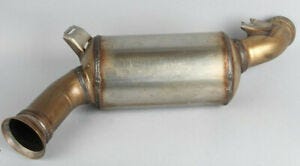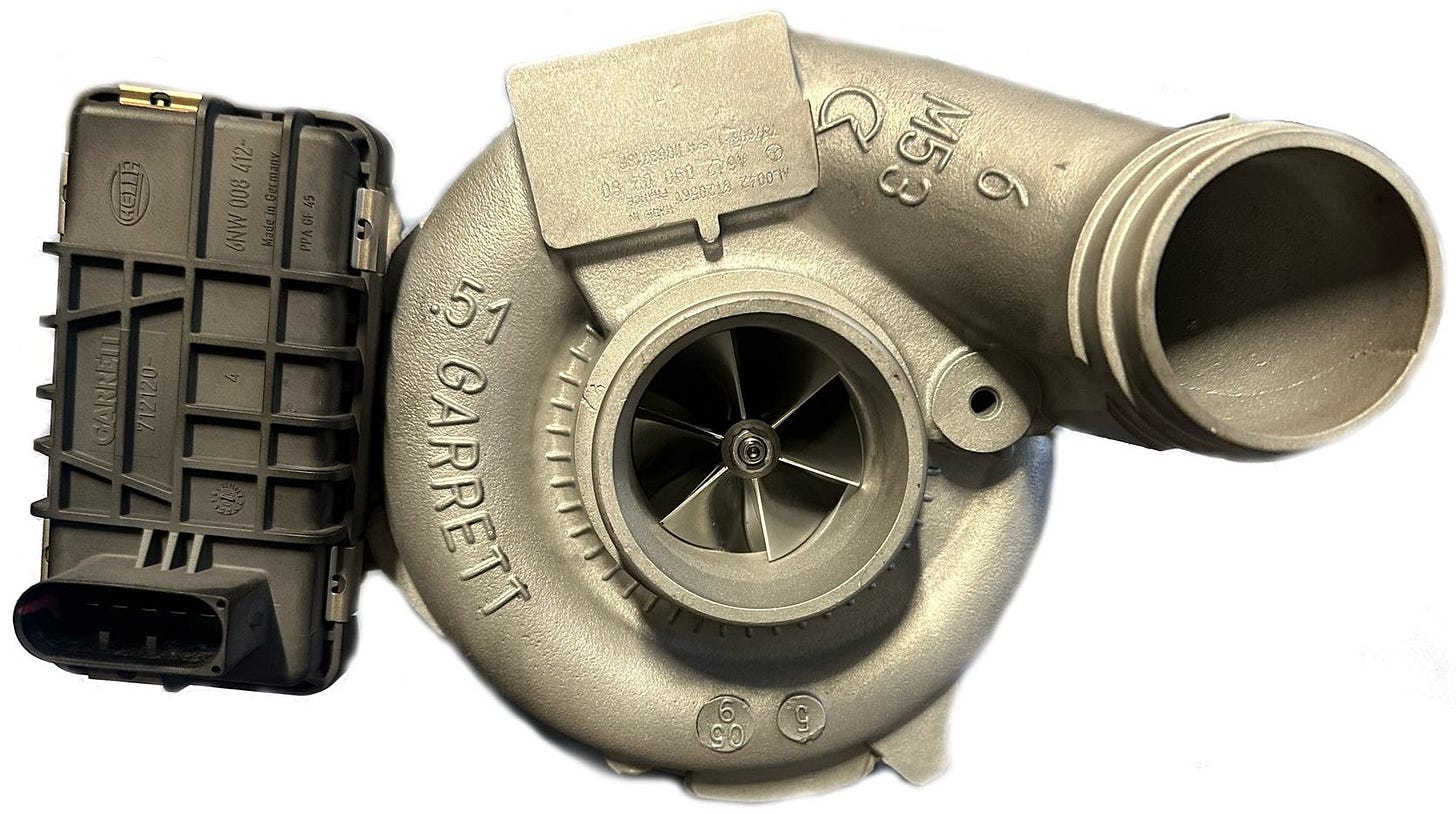18 July 2023 Update: Heads Up!
I’m not going to go into detail on it, but I’m working with another tuner right now. I blew a LOT of time troubleshooting the tune I got from ECU Tuning Kaunas and wasn’t satisfied with the replies I received from my enquiries about what the causes might be. I’m admitting a mistake on my part and moving on. So, for your information, I cannot recommend ECU Tuning Kaunas for parts or tuning.
I will share my experience with a new tuner when we get a little further down the road on this effort.
With that said, I’m leaving the rest of this article in its original condition.
Thanks!
—Mark-A-Billy
Should I pursue a crazy 400 hp build, or should I go for something milder and get better fuel economy? Can I build and drive the best of both worlds?
Current Project Status
I’m in the middle of several efforts and I’ll share them in video format very soon. This writeup shares what I’m doing to my E320 CDI.
Background
I bought Evonne the Turbodiesel in mid-December and drove the machine from Florida to its new home in Ohio. It’s a car with strong potential and a solid mechanical foundation to build on, even though it sat in the Florida sun its whole life and got baked pretty badly. Sure, the price was good for a driveable 2005 E320 CDI with the famous OM648 engine under the hood, but just about anybody out there with some sense might ask: “What the hell are you trying to do, Mark-A-Billy?”
A life lived well involves a fair amount of exploration and experimentation. Diesels are well-suited to this, with potentially large paybacks on both power and efficiency. An article I wrote in early December mentions that I might buy this car and goes into a lot of detail about things that I’ve seen done with the W210 chassis E300s and their high-revving OM606 engines. I even found a deal in the NorthWest and talked to the owner about a machine, finally deciding not to drive an unknown 24 year old vehicle with known issues cross-country, even though it looked like a great deal.
The Tradeoff
The bottom line is that the older indirect-injection diesels simply don’t achieve the fuel economy of the later common rail diesels. I’ve owned a couple of OM642 powered vehicles (and my wife is still driving her ML320 CDI) and one of them was achieving 30 mpg after all day on the highway at 75-80 mph on several occasions. I really need a decent daily driver that can be used on trips and gets good fuel economy. At the same time, I want it to be fun to drive. By switching to a lighter sedan with a simplified diesel, I expect that can achieve improvements in both efficiency and torque.
This Specific Model
The 2005-2006 E320 CDI vehicles with the W211 chassis are the only cars available in America with a legendary Mercedes inline-six turbodiesel equipped with a common rail injection system. These are also the last years before the EPA cracked down on diesel emissions in the US and made diesel engines a claptrap nightmare to be compliant (…unless you are a crafty engineer at the Volkswagen-Audi Group, right?). The OM648 sets a sweet spot where effective technologies meet a reasonable level of simplicity where both efficiency and performance are available.
So, while I might still build a wild OM606-powered W210 machine in the future, my OM648 vehicle will be a reasonable performer with excellent efficiency. A perfect daily driver.
What performance level am I really going for? I researched quite a bit to get a feel for what people have done, what performance figures were possible, and what setup might make for a decent daily driver.
The wild end of the spectrum:
Black Smoke Racing W203.5 wagon’s OM648 is tuned to 700 hp and over 700 lb-ft of torque. This is for an over-the-top drift machine designed for stylish sideways-driven showmanship. It’s very cool, but there are no considerations for fuel economy or on-road driveability.
Dieselmeken has a similar OM648 setup with 600 hp and about 700 lb-ft of torque. Another over-the-top race machine, but these machines display what the OM648 can be built to do.
On the mild end of the spectrum:
Tunezilla (Malone, who I’ve used in the past) will tune this engine to 236 hp and 444 lb-ft of torque with no mechanical modifications. With the right options, their tuning can compensate for deletion or disable DPF, EGR, and intake swirl flaps. This would already be a remarkable improvement. My wife’s ML320 CDI is a 5,000 lb SUV and is tuned to about 440 lb-ft, though we used Green Diesel Engineering for that (but I don’t see them tuning Mercedes anymore). Even at its weight, 440 lb-ft makes it snappy and fun to drive. A friend once joked about pulling stumps, but I told him that I caught my wife doing exactly that one day… In a 3,600 lb car like Evonne, 444 lb-ft would be more than adequate, but I wanted to take this build a little further.
In the middle, somewhere:
I’m going to pursue a Stage 2 build, but of course different people will have different definitions of what Stage 2 is. Generally Stage 1 is only a tune with perhaps a deletion or two, while Stage 2 involves the first steps in truly upgrading hardware. Here are the elements of my specific effort:
1. Clean up the intake
There are restrictions in the intake in multiple areas that will be removed.
The EGR system has a tube in the mixer pipe where air enters the intake manifold that puts a sizeable restriction in the airflow.
The EGR system has also caked the intake of the mixer and intake manifold with a tarry mixture made from the combination of crankcase ventilation oil mist and sooty exhaust. This will be cleaned out and EGR will not be reinstalled on this engine. It simply doesn’t belong on a diesel engine.
There are silencers along the flow path that will be removed.
Believe it or not, the stock filter and filter box will remain. The filter has a lot of surface area, making it look like it belongs to a big truck engine and the filter box actually gets ram air from the front of the car. Others have achieved 400+ hp while leaving this intact.
3. Clean Up the exhaust
There is a catalyst in the downpipe that creates an unnecessary restriction. These things can also get plugged up over time. In the short-term, the catalyst will simply be removed. In the long-term, I’ll build a smooth flowing downpipe.
Mercedes has a civilized, luxury image and the cars are expected to be quiet. My diesel will have more snarl as I remove the overly-restrictive mufflers and put some straight-through turbo mufflers in their place.
The dual exhaust system runs from a Y-pipe right after the downpipe all the way to the back. The pipes are only 2 1/4”, but there are two of them and others are making 400 hp by simply removing the cat and mufflers. The existing pipes will flow well enough for my purposes.
4. Upgrade the turbo
I’ve purchased a hybrid from ECU Tuning Kaunas. It’s very cost-effective, and others have made 400+ hp using this turbo. It isn’t too crazy on the turbine or compressor wheel sizes, so it will still spool quickly and minimize turbo lag. It does feature a machined billet compressor wheel.
To go with the increased boost levels, I’ll install a 4-bar MAP sensor.
5. Upgrade the intercooler
I’m installing a Mishimoto J-line intercooler. It flows better than stock, can deal with at least 40 psi, and others have used it with good success.
6. Leave the injection hardware ALONE!
You heard me right. I’m not upgrading the injectors or the high pressure pump. The stock units are good for at least 300 hp. All of my upgrades above will actually improve the efficiency of the engine, provided my right foot doesn’t get too heavy very often. However, the step of upgrading to larger injectors sacrifices the stock system’s fine spray pattern in favor of delivering more volume. This reduces efficiency.
7. Tune it all
These components won’t work together very well unless the engine and transmission are tuned for them!
I’ve paid for an engine tune by ECU Tuning Kaunas. They are my turbo source and I want a system that works well together. They expect that this engine will be able to put out 300+ hp and 500+ lb-ft of torque, which will make this car very fun to drive.
I’ve also paid for a transmission tune by ECU Tuning Kaunas. It would be foolish not to upgrade the transmission settings to go with the torque increase. By adjusting the settings we can ensure that the transmission holds up. Again, I’m using a combination of components that go together for the best results. This tune will give firmer shifts and better shift points, especially when I put it in (A) Agility mode. The tune will also give me (M) Manual mode where it shifts only when I tell it to by bumping the shifter left and right.
Expected Results
I’m shooting for 500+ lb-ft in a 3600 lb, rear-wheel drive sedan, which will be a lot of fun to drive. At the same time, however, I believe my efficiency improvements will get this car to 40+ mpg highway.
That’s all reasonable, right?
—Mark-A-Billy







